Whether the material they’re selling is soapstone or stainless steel, quartz or laminate, online storefronts focus on the glossy “after” images. Rarely do they tell you how the countertop of your dreams is mined or manufactured, shaped, and precision cut. A major wave of technological innovation has swept the countertop fabrication industry, so much so that CNC (computer-numeric control) is beginning to filter down to the hobbyist level.
You yourself probably won’t be using CNC to outfit your kitchen with countertops, however. Countertop production is still challenging, highly skilled work, requiring sophisticated and powerful machinery. In addition, most materials still require hand finishing, if only for sealing and polishing. While manmade materials like solid surfacing and engineered stone are doing a remarkable job of mimicking the look of natural materials, wood, and even metalwork, they lack the hand finishing that gives the timeless, natural materials a sense of continuity with the past.
No matter what the material, fabrication shops make extensive use of mechanized equipment for everything from heavy lifting to machining technologically sophisticated cuts, bends, grooves, and crisp or rounded edges.
Pro Tip: Natural stone blocks are usually cut into slabs on site. The slabs from the same block are shipped together for continuity of pattern and color to individual stone fabricators around the world.
Stone
Natural stones including granite, slate, soapstone, and marble are quarried in large blocks in locations all over the world. Marble is famously mined at Carrara, Italy, and other sites around the globe. Today’s countertop-quality soapstone comes from Brazil, Turkey, India—and Virginia, where one of the densest and most desirable soapstones, albarene, has been mined for more than 150 years.
With the row of cutting heads in the background, a CNC machine prepares to round and smooth the edges of a counter. Jim Polson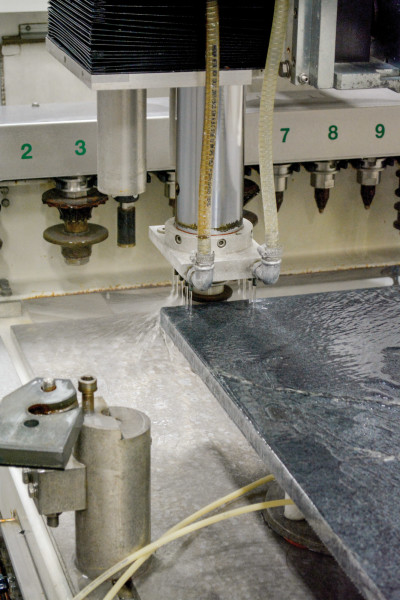
Slabs vary in size, but most are between 8′ and 9′ long, and 5′ to 6′ wide. Simply moving a marble or granite slab weighing between 600 and 800 pounds into the work zone requires a forklift. For more delicate maneuvering, each precious piece is then picked up and moved either vertically or laterally, using a suspension cable vacuum device hung from a crane. (Suction cups hold the stone in place.) The cable system allows the heavy slab to be angled in any direction until it meets its resting place on the cutting bed.
While there are variations in the methods used from fabricator to fabricator, natural stones including granite, marble, and soapstone, and engineered stone (a category that includes quartz) are cut in much the same way. Most shops still use plywood or cardboard templates made at the installation site to plan the cuts on stone. (Precise measuring means that as much of the slab as possible can be used, minimizing waste.) In a CNC-equipped shop, the physical template is then marked at key points at regular intervals, and the data is then transferred to a CAD (computer-aided design) program. The program draws up the template and transfers the information numerically to the cutting bed, where a CNC (computer-numeric control) machine will ultimately cut and shape the pieces.
The CNC machine actually visualizes the cuts to be made on the slab, sending a picture back to the CNC operator. Then it automatically selects one of more than a dozen mill blades (cutting heads) with different profiles to make the initial cuts using a wet saw equipped with diamond-encrusted blades.
Since all of the initial cuts are sharp, the edges must be polished, either with a CNC milling machine or by hand. Many manufacturers use waterjet machines for curved and angled cuts. The waterjet cuts, shapes, and drills using a high-pressure jet of water mixed with an abrasive material. The amount of pressure and the type of abrasive needed varies depending on the type of stone, its density, and even its color.
All cutting and shaping is done with water, from polishing with abrasive diamond grinders down to hand finishing. That’s because exposure to small bits of silica in the stone can scar the lungs of workers, causing silicosis. “If you do all the cutting wet, there is no dust,” says Roger Teixeira, a soapstone dealer and fabricator in Glen Rock, N.J. Even so, he encourages his workers to wear protective masks at all times.
Installation and fitting is often part of the work order. A good fabricator will custom-fit the pieces of stone onsite, join seams with color matched two-part epoxy, and make any necessary adjustments. At least one soapstone fabricator, Vermont Soapstone, cuts countertop and sink pieces to rough measurements in the shop, then does all the final cuts, shaping, and fitting onsite, using a pop-up fabrication shop.
Butcher Block
Since its early use in the 1870s, butcher block has been a versatile work surface in the kitchen. Unlike flat-grain or plank wood tops, butcher block is formed from strips of hard maple, oak, or another hardwood glued and pressed together, then turned so that the hardest, most durable grain surfaces (either edge grain or end grain) form the cutting surface. Since even tightly grained wood is vulnerable to water penetration, butcher block is sealed with a food prep-safe oiled finish.
Building a butcher-block counter begins with careful selection of the wood. Lumber is sorted by grade, then air- and kiln-dried. Once the lumber comes into the fabrication plant, it’s planed and sanded to create a flat, smooth work surface. Next, it’s run through a rip saw that cuts the wood into rails that are a consistent 1 ¾” x 1 ¾”. To make edge-grain countertops, premium rails are laminated and glued together side by side, forming a solid piece of butcher block where the wood grain lines run in linear fashion along the rails.
Making end-grain butcher block literally requires turning edge-grained butcher block on its head. Laminated edge-grain boards are glued and stacked on top of each other, then placed in a screw press, which squeezes the wood and glue together. After drying, the block is set on end so that the end grain of the rails faces up as the work surface.
A drainboard sink made by Specialty Stainless is seamlessly integrated into the backsplash and counter, which has a recessed drainboard and hand-polished grooves.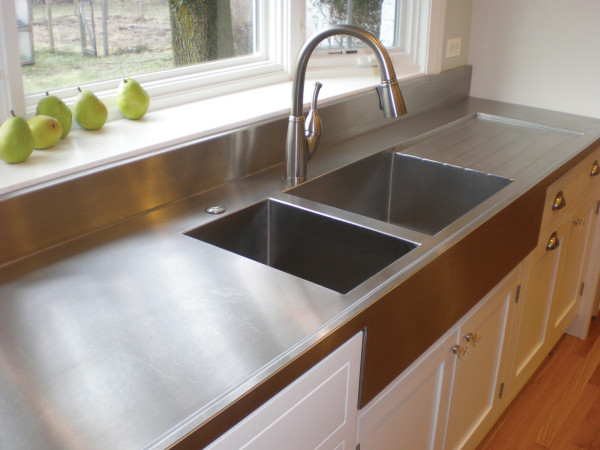
Stainless steel (and the increasing rare, nickel-based Monel) have been in use in the kitchen for well over a century. Easy to bend and shape, stainless steel is a superb surfacing material for counters and sinks. “One thing about metal, you can integrally weld everything together,” says Jeff Subra, owner of Specialty Stainless in Buffalo, N.Y. “You can’t weld a sink into quartz.”
Steel fabrication has its own set of specialty machinery, usually including punch or shear machines and press brakes. The machines can be hydraulically or pneumatically powered, or CNC-controlled. At Specialty Stainless, all of the cutting and “nibbling” is done on a CNC punch machine. A flat sheet of 16-gauge steel is placed on a pneumatic hydraulic table where the punch machine cuts out holes for sinks, faucets, and soap dispensers.
The countertop then goes to a CNC press brake, which tools the metal using a punch and die setup. The edge of the sheet is placed in the machine by one or two workers, then quickly crimped all along the edge. A simple bend, like a 90-degree right angle, may require only one “hit” on the machine. The more complex the curve, the more bends. The skill comes in knowing how to position the sheet and where to place it for subsequent bends.
Seams and corners are formed up using TIG (tungsten inert gas) welding, which reduces the emission of sparks. Sinks are hand-formed rather than punched, and surfaces are hand-peened to make radius edges. Once the sink is formed up, all welds are ground and polished by hand. “We hand-build all our own sinks,” Subra says. “The metal thickness stays true because it isn’t stretched or stamped.”
Unlike stone and wood surfaces, stainless steel requires no sealer. When polished, it forms a film that gives it antimicrobial properties. While stainless steel arrives at the factory with a standard polish, Specialty Stainless does custom finishes such as its antique finish: a dull, random finish similar to matte nickel or pewter.
Stainless Specialty also works in copper, zinc, and aluminum. Subra notes that copper has become almost prohibitively expensive; zinc will not last nearly as long as steel because the zinc top coating eventually wears away if not maintained; “stainless steel can last indefinitely.”
Leonardo Ribeiro, production manager and shop foreman, lowers a stone slab into position on the cutting bed.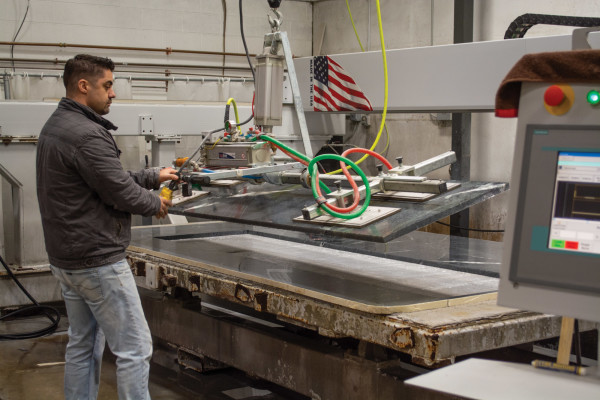
Shop Tour:
For an introduction to the wonders of soapstone fabrication, I visited M. Teixeira Soapstone in Glen Rock, New Jersey. Before I’d even walked in the door, I noted an entry landing made from scrap soapstone, scored to prevent slipping in wet or icy weather. More soapstone tiles line the entry foyer; beyond that is a sumptuous, double-ended tub carved from a single block of stone. Further on in the petite showroom are displays of soapstone countertops with integral and custom carved sinks (a specialty of Bucks County Soapstone, a frequent collaborator), a soapstone-tile floor and, surprisingly, samples of engineered stones and a porcelain countertop installation.
The sharp edges of a grooved countertop are hand-sanded by Angel Paguay.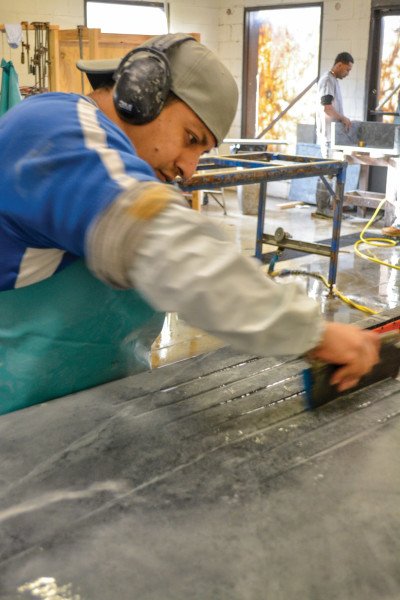
“Soapstone is just one of the options customers have in mind when they walk in,” says owner Roger M. Teixeira, noting, too, that using more than one surfacing material in a kitchen is becoming popular. “People are mixing Carrara marble and soapstone . . . using one on the island and the other on the counters around the perimeter.”
Beyond the showroom is the workshop, set up with CNC machines and a control booth. At the back is the hands-on part of the shop, where sinks are fitted and epoxied together, and sink bases are laboriously hand-sanded to direct water toward the drain. While CNC machines can do many things, handwork is sometimes more efficient, Teixeira says. One example is sanding down drainage grooves on a counter. “The grooves come out very sharp, and we bring it back here and smooth it out by hand.”
Teixeira offers two kinds of sinks: those carved from a single piece of stone, and the more affordable sinks that are pieced together. Simply putting a sink together requires a lot of skill. Each side is cut with rabbet or tongue-and-groove joints and notched to absorb epoxy, then dry fitted to make sure all the sides are square and fit together perfectly. Finally, the sink is glued together and the epoxy is allowed to cure before it’s tested with water.
The Faces of Wood
Wood can be cut and configured in many ways, but only a handful of methods produce countertops that will stand up in the kitchen: face grain, edge grain, and end grain. All need regular coats of penetrating food-grade oil to protect them from water and stains to maintain their longevity.
Face-grain (or flat-grain) counters are constructed from full-width planks. The surface has a wide grain pattern that reveals the natural patterns in the wood. Though excellent for serving, they’re the least suitable for chopping or cutting. Even if the wood has been sealed, do not let water sit on the surface.
Edge-grain countertops are constructed using strips cut from wider boards that are placed on edge and joined together. This creates a countertop where grain lines are mostly straight, producing a hard and stable work surface. It’s also more cost-effective compared to end-grain countertops.
End-grain countertops are constructed using square or rectangular blocks arranged so that the ends of the wood strips (growth rings) are visible on the surface. Though more expensive, end-grain construction is ideal for cutting boards: the wood orientation is easier on knife blades, can“self heal,” and is more sanitary.
An end-grain butcher-block work station alongside a face-grain drainboard countertop, both made by DeVos Woodworking. 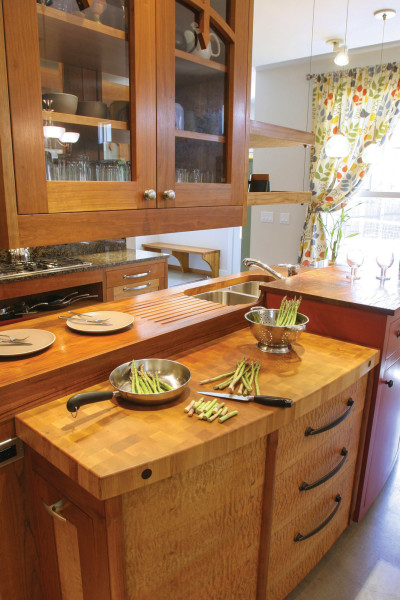
Wood Cuts for Counters
Wood presents different grains depending on how it’s cut. The most familiar is face grain, cut through the tree vertically to produce boards. Cutting face-grain boards vertically into strips of uniform size (e.g., 2 x 2s) produces edge-grain wood, where the grain lines are mostly straight. Joined together, these uniform strips form a hard cutting surface called butcher block. In the densest, most durable butcher blocks, rows of joined edge-grain strips are turned face up, so that the growth rings are on the cutting surface.
These mined blocks of marble are at the Ortensia quarry in Carrara, Italy. Courtesy Fox Marble/foxmarble.com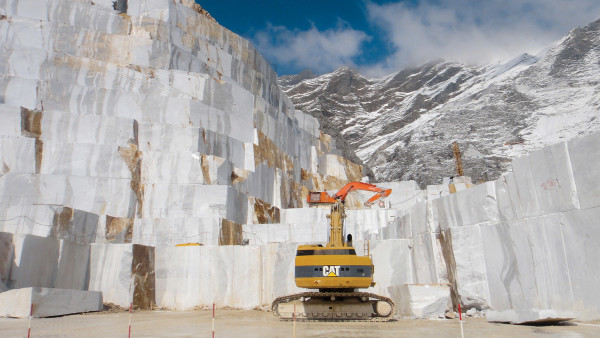
Marble and its Admirers
Endlessly appealing in soft shades of honed or polished white, grey, black, and cream, marble is one of the most prized materials for countertops. That’s in spite of its many drawbacks: marble is relatively soft, which why it takes so well to carving. It stains and etches easily, requiring frequent sealing and careful cleaning to maintain its beauty. Like many natural stones, it can be chipped or cracked and will break if enough pressure is applied.
The demand for marble has spawned a sub-industry in marble lookalikes, beginning with marble-look laminates and continuing with solid-surfacing materials and engineered stones. Most have advantages that marble cannot offer, and several manufacturers offer gorgeous lookalikes. Most cost more than marble (or any other natural stone), but never need sealing and are easier to care for.
Another material that does a convincing imitation of marble is porcelain, which is just catching on in North America after wide acceptance in Europe. Porcelain is made by wet-grinding clay together with feldspar-rich materials and ceramic pigments; it’s then poured into slabs and shaped by compaction. The material is fired at temperatures in excess of 1000 degrees F. Porcelain countertops are resistant to impact, scratching, heat, and UV, impervious to stains and chemicals, and completely waterproof.
As a countertop material, it’s also lighter and thinner than most natural stones (at /” to /” thick), so it works well for backsplashes and as wall and floor tile. (Porcelain tiles are so strong, one European manufacturer shows a horse walking over a porcelain tile floor.) Like solid surfacing and engineered stone, porcelain does not require sealing, and cleans up with a damp cloth and a pH-neutral detergent.
Porcelain slabs are fabricated similarly to natural stone and bonded materials, using water-based saws and other CNC technology. Manufacturers like Crossville Tile specify cutting speeds based on disc diameters and cutting angles in order to minimize the chance of breakage.
Corian can be thermoformed, which means it’s easy to create integral sinks, grooves, and changes in surface height.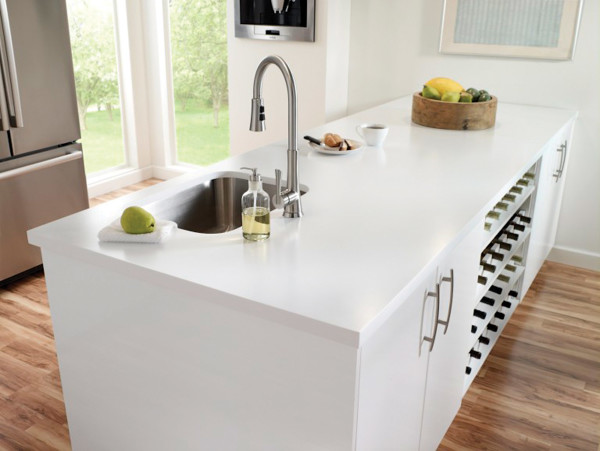
Solid Surfacing vs. Engineered Stone
Composite countertops come in two varieties: solid surfacing and engineered stone. Solid-surface countertops, invented in the late 1960s and marketed as Corian by DuPont, are made by blending acrylic polymers with mineral dust and pigments. The much more recent engineered stones, including quartz countertops (brands include Silestone, Caesarstone, Cambria, and many others), are made of crushed quartz or other stone (about 95%) bound together with polymer resins
(5% to 7%).
Hard and durable, both materials have advantages over natural stone in that they are nonporous and don’t require sealing. Both are stain-, scratch-, and heat-resistant—to a point. A very hot cast-iron skillet (212 degrees F. or higher) can damage a solid-surface counter. Sharp changes of temperature, and exposure to temperatures higher than 300 degrees F. can damage engineered stone counters, too. Exposure to ultraviolet light can lead to discoloration over time. Both materials are fabricated like natural stones, but are more forgiving in that the material is consistent throughout.
A sink fabricated from Northeastern mottled green slate, by Sheldon Slate.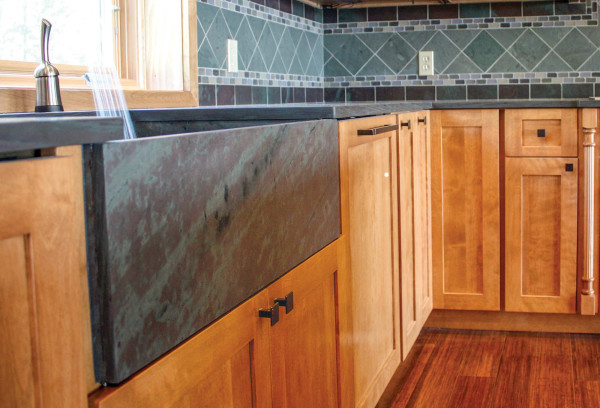
Native Stone
Looking for a natural material mined in the U.S.? In addition to native soapstone from Virginia and Vermont, two options are slate (mined in New York, Maine, and Vermont), and schist from Massachusetts. Slate comes in beautiful colors, from light grey to charcoal, light to dark purple, light and medium green, soft red, plus greens and greys streaked or pocked with purple. Countertop-grade schist from Massachusetts includes startling patterns dubbed Crow’s Foot and Quicksilver. Both slate and schist are beautiful, dense,
and long-lived options.







